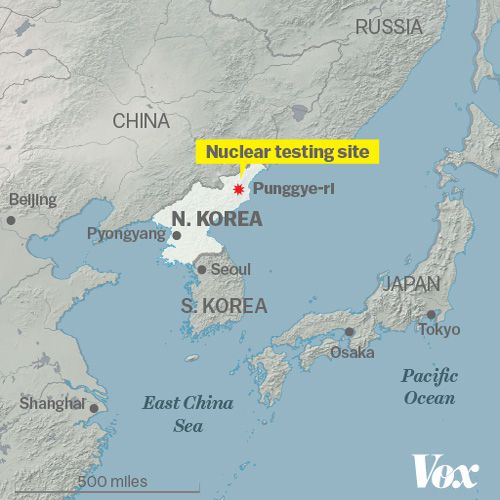 |
| That right there is where the action is |
First, what is a Hydrogen Bomb? We discussed that at some length here, so I'll just summarize. The design in use around the world today is called the Teller-Ulam design, named after the scientists that developed it. It's essentially a two stage device that uses a standard fission device to trigger some additional yield through a fusion reaction. It's worth noting that even with a well designed Teller Ulam device, the lions share of the energy released is through fission, not fusion. Why build a device like this? Well, the breathless reporting is around the tremendously huge yields the design can produce. Ten, twenty even FIFTY megaton city killers can, and have, been built. But nuclear strategy has evolved, and as the weapons have gotten smaller and the delivery systems more accurate, most warheads are of the variable yield type, with the maximum yields around 250-300 kilotons. The real value of an effective Teller-Ulam physics package is that it allows the use of much less fissile material, resulting in more, smaller, more deliverable, more efficient weapons.
Ok, that makes sense for nations with large stockpiles. Why would North Korea want a bomb like this? The answer is they wouldn't. The design is difficult to get right - remember that the detonation is initiated by an atomic bomb. EVERYTHING that happens after that has to happen in the microseconds before the bomb breaks apart and is vaporized by that initial blast. Get a tiny detail wrong, you get the energy release of the primary and nothing more. In the nuclear weapons argot, this is called a 'fizzle'. There would be no reason for North Korea to add that level of complexity and reliability problems to their tiny stockpile when plain old fission or boosted fission weapons would serve them just as well. Indeed, Israel has never developed a two-stage design, preferring to hew to the tried and true boosted fission designs they know they can count on.
So why would they make the claim that they tested an H Bomb? Well, first the Kim dynasty has a long history of making outrageous claims. It's primarily for their domestic constituency, who tend to worship the generational leadership with something approaching religious fervor. It's important that they see a modern, advanced, technologically competitive government rather than the impoverished backwater criminals we know them to be. But it is also true that these sorts of claims tend to resonate in the international diplomatic community at a level far out of proportion to their reality. Once again, we're all talking about the type of device rather than the policy ramifications of another nuclear test in Northeast Asia.
In the end, the important reality isn't the weapons at all - it's geography. Just 90 seconds flight time from the border along the 38th parallel is the South Korean capital of Seoul, a huge, modern metropolis of ten million souls. Whether with nuclear weapons or massed conventional artillery, the North knows they hold that city at perpetual risk. In any outbreak of hostilities, the Kim government might well fall, but the cost to the south in lives and treasure would be atrocious. Seoul is their deterrent, and everything else is just propaganda and positioning.
...
All of their tests have involved fairly weak yields, this one producing the largest yield so far at about 10kT. That makes them all weaker than either of the WWII detonations, so why would you think that this one was boosted? The more probable explanation is that they just wanted some attention(food) and did a stunt proven in the past to get that attention.
ReplyDeleteYield is meaningless. You're testing designs, not devices. The US has done HUNDREDS of tests with yields of less than 10kt.
DeleteBoosted fission describes a design strategy of a physics package - not a specific yield range. Indeed, the primary US nuclear gravity bomb, the B-61, uses a variable yield type fusing that can be configured to less than 0.5kt.
NorKor tests are always at least partially for propaganda advantage, but don't ever assume that the small yields mean poor weapons design. 1.)you want to test your designs, but you don't want to use up a large portion of your stockpile doing it; 2.) they are trying to miniaturize the warhead for deliverbility reasons, so the yields are likely to be smaller; and 3.) don't kid yourself - a 10kt blast in Seoul would be horrific. Do the math - that's TWENTY MILLION TONS of TNT...
I saw Spotlight yesterday with my dad.
ReplyDeleteIt's pretty good, I think you'd like it, mikey.
~